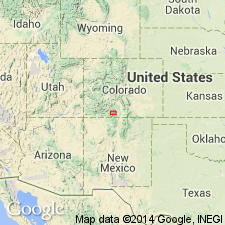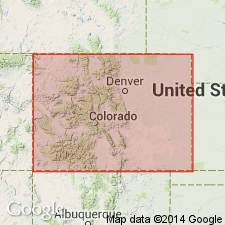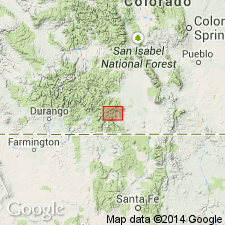
- Usage in publication:
-
- La Jara Canyon Member*
- Modifications:
-
- Named
- Dominant lithology:
-
- Quartz latite
- AAPG geologic province:
-
- San Luis basin
Summary:
Named as a member of Treasure Mountain Tuff for exposures in La Jara Canyon, 37 deg 10 min N, 106 deg 20 min W, its type locality about 27 km southeast of Platoro in Conejos Co, CO in the San Luis basin. Is a multiple flow compound cooling unit of phenocryst-rich quartz latite. Is the first widespread ash-flow sheet in the eastern and central San Juan Mountains. Caused the first major collapse of the Platoro caldera. Is about 100 m thick at type. Its maximum thickness outside the caldera is 300 m. Original total thickness was possibly more than 1,000 km. Lies 40 m above base of formation, above an unnamed lower tuff and below an unnamed middle tuff. Has a K-Ar radiometric age of 29.8 m.y. Is characterized by reverse magnetic polarity. Assigned to the Oligocene.
Source: GNU records (USGS DDS-6; Denver GNULEX).

- Usage in publication:
-
- La Jara Canyon Member*
- Modifications:
-
- Overview
- Areal extent
- AAPG geologic province:
-
- San Juan basin
- San Luis basin
- San Juan Mountains province
Summary:
La Jara Canyon Member, oldest member of the Treasure Mountain Tuff. Areal extent of La Jara Canyon in southwestern Colorado shown on distribution map; present in Archuleta County (San Juan basin), Conejos and Rio Grande Counties (San Luis basin), and Mineral County (San Juan Mountain province). Composed of quartz latite. Derived from the Platoro caldera. Had an estimated volume of more than 500 cubic km. Age is 29.8 m.y.
Source: Modified from GNU records (USGS DDS-6; Denver GNULEX).

- Usage in publication:
-
- La Jara Canyon Tuff*
- Modifications:
-
- Revised
- AAPG geologic province:
-
- San Juan Mountains province
- San Juan basin
- San Luis basin
Summary:
Rank raised to a tuff of the Treasure Mountain Group (rank raised). Study area is within southeastern San Juan volcanic field, Archuleta (San Juan basin), Mineral (San Juan Mountain province), and Rio Grande and Conejos (San Luis basin) Cos, CO. Is widespread and voluminous ash-flow sheet of phenocryst-rich dacite, with an estimated volume of over 1,000 cubic km. Rank raised because unit is as voluminous as some tuff sheets designated as formations elsewhere in San Juan field. In prior interpretations, most of exposed features within Platoro caldera were interpreted as related to eruption of La Jara Canyon, however, recent work demonstrates that intracaldera tuff is Chiquito Peak Tuff (new) rather than La Jara Canyon. Younger than Black Mountain Tuff (new) of Treasure Mountain; older than middle tuff of Treasure Mountain. Dated as 29.3 Ma (Oligocene) (table 1).
Source: GNU records (USGS DDS-6; Denver GNULEX).
For more information, please contact Nancy Stamm, Geologic Names Committee Secretary.
Asterisk (*) indicates published by U.S. Geological Survey authors.
"No current usage" (†) implies that a name has been abandoned or has fallen into disuse. Former usage and, if known, replacement name given in parentheses ( ).
Slash (/) indicates name conflicts with nomenclatural guidelines (CSN, 1933; ACSN, 1961, 1970; NACSN, 1983, 2005, 2021). May be explained within brackets ([ ]).

